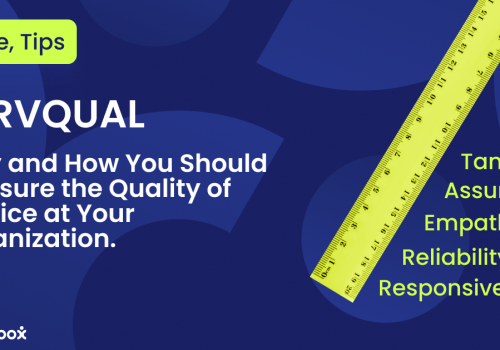Customer Service Metrics. In 2023, we run businesses almost as a science. We’re interested in the data, the analytics, the metrics, and how we can use these to take our business to the next level. This is all about taking the guesswork out of business and instead relying on cold, hard data. By implementing and tracking your customer service metrics, you can continually monitor your performance and gain actionable insights.
There are 10s or maybe even 100s of metrics you can track in the digital age. It’s no longer a problem of not having enough data like it was in the past. We’re now data-rich and the problem is now in deciding which metrics to track. With so many metrics out there, how do you decide which are best for your business? That’s what we’re going to answer today. We’re going to give you 14 customer service metrics that you should be tracking. Let’s take a look.
14 Customer Service Metrics You Should Measure
1. Customer Satisfaction Score (CSAT)
Your customer satisfaction score is an indication of how satisfied your current customers are with your product or service. Customer satisfaction scores are determined by asking the customer to fill out a short survey where they rate their experience using a predefined scale, for example, 1-3, 1-5, or 1-10. Customer satisfaction surveys are about as simple as you can get in terms of customer surveys. The goal is to get a clear indication of how satisfied your customers are. To get a clear indication, you want to make the survey easy to fill out, is short (so that the customer isn’t put off by how long it will take), and to use straightforward wording. Surveys like these only give you a true picture of your customers’ feelings when a large number of customers take part.
You can simply ask the question:
“How satisfied were you with your experience today? Please rate your experience from 1-10 with 1 being terrible, and 10 being excellent.”
Customer satisfaction surveys are best used at key points in the customer journey. For example, you can use the survey after the customer has bought a product, before the customer renews their subscription, or after an interaction with customer service.
Customer communication platforms like CommBox allow you to measure your CSAT by sending surveys automatically on any conversation, whether it’s through WhatsApp, Facebook Messenger, Web Chat, or any other channel.
Find out more about the CommBox smart customer communication solution
2. Customer Effort Score (CES)
The customer effort score is an indication of how much effort is required of the customer to use your product or service. CES is determined by asking the customer to rank their experience from 1-7. For example, let’s pretend you offer photo-editing software called PhotoFuelLabs (not a real product or company), you might say:
“Rate how much you agree with this statement: PhotoFuelLabs allows me to complete all photo editing tasks required of my work or hobby”. You would then provide a 1-7 scale, where 1 is “Strongly disagree” and 7 is “Strongly agree”.
CESs will give you a good indication of whether your product is fit for purpose, and whether the customer is likely to continue using the product.
3. Customer Retention Rate (CRR)
Customer retention rate is exactly what it sounds like: the percentage of customers the company has retained over a given period. Knowing your CRR is crucial because the probability of selling to an existing customer is 60-70%, whereas the probability of selling to a new customer is 5-20%. Additionally, 80% of your future profits will come from just 20% of your existing customers. With this in mind, you should be focused on understanding your CRR and trying to increase it.
You use this simple formula to work out your CRR:
Customer retention rate=((E-N/S) *100
E: The number of customers at the end of a period.
N: The number of new customers gained during that period.
S: The number of customers at the start of the period.

4. Net Promoter Score (NPS)
The NPS is a measure of customer loyalty and how likely your customers are to promote your business. Customers are asked a single question:
‘How likely is it that you would recommend [Organization/Product/Service] to a friend or colleague?”.
The customers are asked to give a rating from 0 (Not at all likely) to 10 (extremely likely). Based on their answer, the customer will fall into one of the following categories:
- Promoters: Respondents who gave a rating of 9 or 10. These customers are very loyal to your business and are likely to promote your brand.
- Passives: Respondents who gave a rating of 7 or 8. These customers are typically satisfied with your service but not happy enough to actively promote your business.
- Detractors: Respondents who gave a rating of 0 to 6. These are typically considered unhappy customers who are unlikely to promote your brand or buy from you again.
5. Customer Churn
Customer churn is the reverse of customer retention rate. Instead of looking at how many customers you retained, you are looking at how many customers you lost. Customer churn is also sometimes called customer attrition. Customer churn causes significant long-term problems for business growth for several reasons. It’s difficult to get a customer back once they leave for a competitor, and that customer may even warn others against your company.
In the past, companies would treat customer churn and customer retention reactively. By this we mean they would only try to persuade a customer to stay once that customer had made it clear they wanted to leave. However, with the advanced analytic tools available in the digital era, companies are now proactive about CRR and customer churn.
You can work out your customer churn rate by using this calculation:
Customer Churn Rate = (Customers beginning of the month – Customers end of the month) / Customers beginning of the month.
6. First Response Time
This is the amount of time (the number of minutes, hours, or days), between when a customer submits a support request and when they receive their first response from a customer service representative. First Response Time (sometimes also called First Reply Time), is considered one of the most important customer service metrics because customers hate to be kept waiting. The longer the customer has to wait, the more frustrated they will become.
7. First Call Resolution Rate (FCR)
The First Call Resolution Rate measures how successful the contact center is at resolving customers’ issues the first time they call. FCR is a good measure of how satisfied your customers are, as well as how efficient your customer service agents are at solving customer problems without needing to rely on follow-ups. One research study found that 60% of organizations who measured their FCR for over one year reported an improvement in performance of up to 30%.
8. Average Customer Support Ticket Resolution Time
The average customer support ticket resolution time is pretty self-explanatory. You can work it out by taking the total time taken to resolve tickets during a selected time period and dividing it by the total number of tickets solved during this time period. For example, let’s say that 1,380 minutes were spent resolving customer issues, and 276 tickets were resolved during this time, the average customer support ticket resolution time would be 5 minutes.
9. Total Number of Customer Support Tickets
This one is also self-explanatory, but crucial, nonetheless. By measuring and tracking the total number of customer support tickets you have the foundation to track a bunch of other metrics relating to these tickets. It’s also important to keep track of how this number changes so you understand how much pressure your customer service team is under and whether you need to hire more staff, implement more tools, or find a more efficient way of working. A sudden spike in this number can also be a sign of a fault or issue with your product, service, website, or app.

10. The volume of Unresolved Customer Service Tickets
The volume of unresolved customer service tickets is the total number of customer service tickets that haven’t been resolved. It’s important to track this number so you can see whether your customer service operation is working efficiently and if more needs to be done to resolve these tickets. You should ideally have the functionality to filter these unresolved tickets by type so you can identify any areas of weakness and prioritize your next steps.
11. Preferred Communication Channel
While not strictly a metric, this is something you should be recording in 2020. Customers love to have options, and they like to know that they are being listened to. There’s no use asking a customer what their preferred communication channel is if you are going to ignore it when it comes to reaching out to them. Your company should offer a range of communication options and allow your customers to choose their preferred method, and maybe even their preferred second or third option.
12. Number of Upsells and Cross-sells
The sales and customer service teams are becoming more intertwined than ever before. The businesses of today are now trusting their customer service agents to upsell and cross-sell to customers while dealing with their problems. Upselling is when you convince the customer to buy a more expensive version of a product, and cross-selling is when you convince them to buy an additional product that complements the first product. You can track how many successful upsells and cross-sells are done by your customer service team to measure how good they are at convincing customers to buy and whether there is room for improvement.
13. The Helpfulness of Knowledge-Base Articles
Most companies know that you shouldn’t leave everything up to your customer service team. This is why they create articles to address common problems. However, you can’t just put these articles up and call it a day. You have to continually measure their usefulness to determine whether they need to be tweaked and edited. The way you do this is easy! You simply have to include a short single question survey at the bottom of the article that says something like “I found what I need: Yes/No” or “Was this helpful?”.
14. Types of Customer Support Tickets
The exact categories of customer support tickets will differ depending on the type of business you operate. However, no matter what categories you decide on, it’s important that you sort all tickets into these categories and that they are useful for your company. Categorizing tickets is a useful way of identifying key problems, frequent problems, and assigning the relevant team member to the ticket.
Here are some examples of categories:
- Sales question
- Technical Issue
- Refund
- Cancellation
- Return
- Shipping
- Product availability
- By product
- How to
Start Tracking Your Metrics Today!
There you go! You now have 14 crucial customer service metrics to help take your business to new heights! Tracking these metrics will help you unlock the power in your data and ensure you’re continually offering a high-quality service for your customers.




















